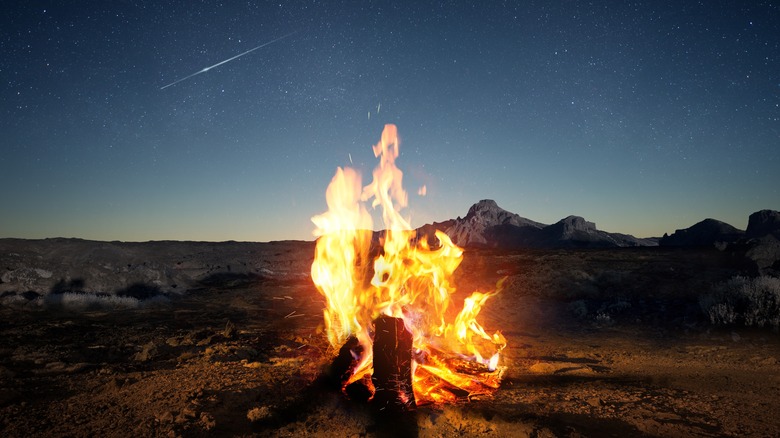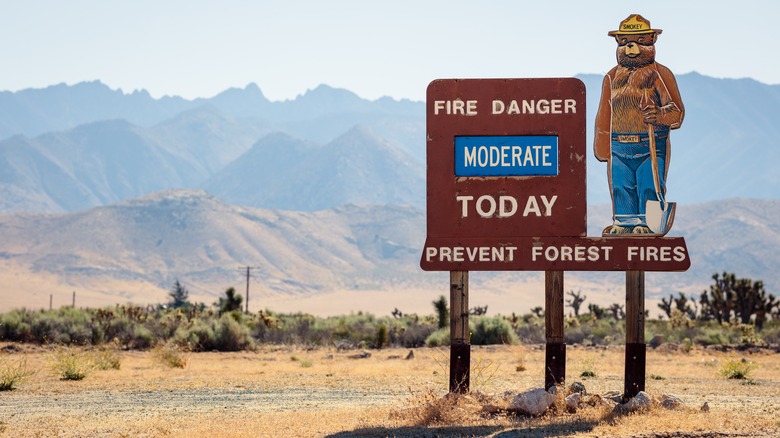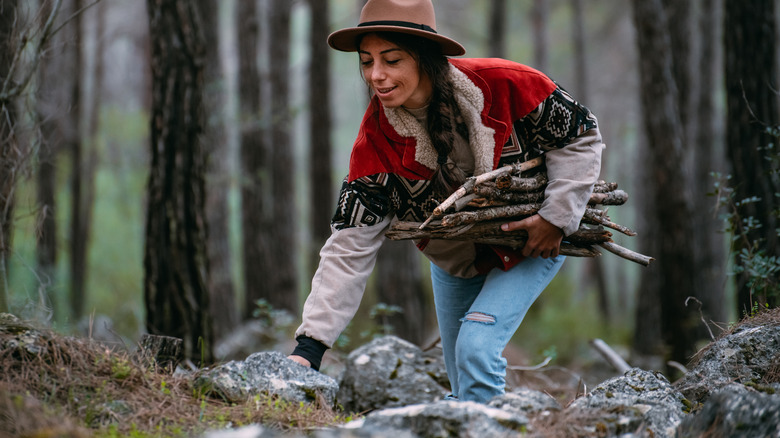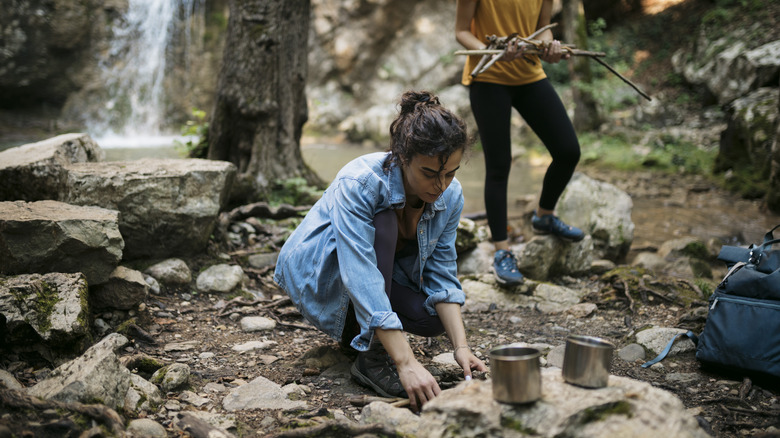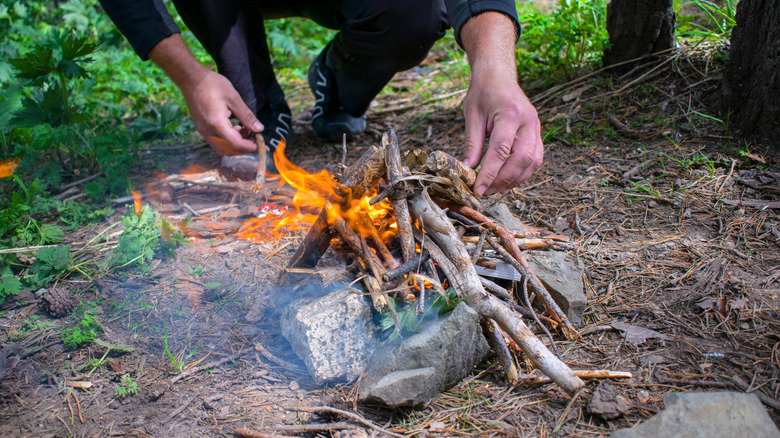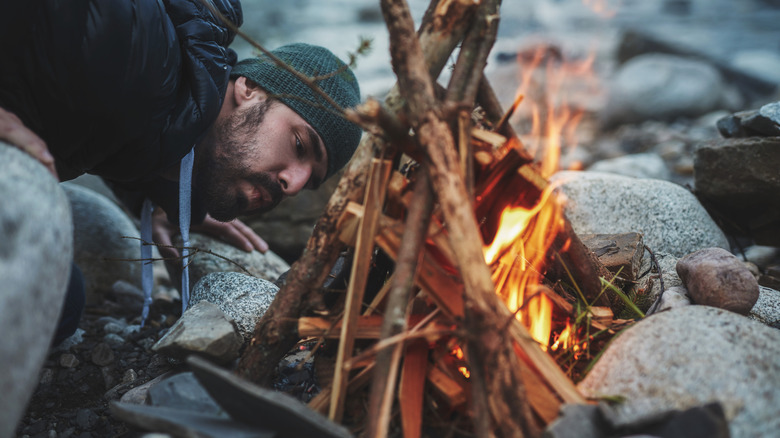The Perfect Campfire Build Explained
We've come a long way from cave drawings and hunter-gatherers, but one tradition has held firm through all the changes: there is still not much in life that's better than a cool night outside sitting around a fire. Maybe it's just because I was raised on the East Coast, where every ember that cracks off from the fire doesn't risk burning down California, but for me, lighting a campfire is an essential aspect of a camping trip. Without a fire, you're not camping; you're just sleeping in the dirt.
Sorry, Billy Joel. This time, we really are starting the fire. This guide will help you get a blaze going with nothing more than a lighter/matches and a bag of Doritos. Learn how to safely gather the right materials from the woods, which food packaging you can use to get things going, and how to stoke your blaze. The only thing we won't cover today is which scary stories to tell while roasting marshmallows.
Safety first
Not paying attention to safety rules and local regulations is a massive campfire mistake. Several governmental and private organizations have laid out great guidelines for lighting campfires safely. Before you start collecting firewood, you should check out these guidelines and understand any rules and regulations specific to your camping area. Any camping area will have its own fire rules, which will be a combination of local weather patterns and our country-wide system.
The National Forest Service uses a National Fire Danger Rating System to help visitors easily understand the risks in differing climates across the country. The system has five different color-coded levels that range from low to extreme. Check out the fire danger level for your camping area before you light up.
Even if the fire danger scale sits low, you should take tons of precautions to avoid burning down your camping equipment or any other nasty surprises. Always identify the closest water source and keep a bucket of water on hand, never light a fire outside of a fire pit, and keep all your firewood stacks upwind and well away from the fire pit. The last (and most important) aspect of fire safety is putting out your campfire completely before bed. Pour water on your fire or bury it in the dirt until the hissing sounds stop. Remember, the best campfire build is the one that doesn't burn the forest down.
Start your build well before dusk
Loading up your car with firewood and driving it out to your camping site is never a good idea. In fact, it can be downright illegal to bring your own logs. This is a blessing in disguise. If you've ever wondered what people do all day after setting up camp, a big answer is collecting firewood. It always takes more wood than you'd think to keep a campfire going, and it's much easier to do the heavy lifting in the daylight. As soon as you've pitched your tent, put on a pair of long pants and head off into the woods.
Putting off your wood collection can doom your fire before it begins. It might sound counter-intuitive, especially if you're camping in a national forest. Sure, there are trees everywhere. However, many variables work against you unless you're car camping with a gas-powered chainsaw. Everyone else will have to scavenge for logs that fit inside your fire pit.
Even if you're staying at an established campground that sells firewood, they might not sell kindling or tinder. You should still set aside a good hour to collect smaller fuel pieces. Plus, you've got to look for the perfect s'mores roasting stick. Don't wait until darkness to try and find kindling. Get it done while the sun is still high.
Collect three different piles of wood
When you head off, you should look for three things: tinder, kindling, and larger logs. Tinder is the smallest and most important material for your campfire build. It's typically a collection of dry leaves, small twigs, pine needles, and any cardboard you've got lying around. Regardless of the specific material you've got at your disposal, the older and more dead it is, the better. Tinder transfers the flame from your firestarter onto your kindling, so gather enough to create a hefty nest surrounding your firestarter.
Kindling takes the form of small sticks and branches that you can easily snap in half. If you find a small branch that bends but doesn't snap easily, cast it aside. That wood is either still alive or broke off from a larger tree too recently. I like to gather massive amounts of kindling, as it's something you can easily throw on the fire in a panic if your flames start to dwindle.
Finally, you'll collect logs. Lots and lots of logs. This can be a challenge to track down without a hatchet or an ax at your disposal, but if you look long enough in the woods, it always provides. Look for rotting trees that you can pick up and mash against another. Once you think you've got enough wood, take the time for two more armfuls. You don't want to run out of wood in the middle of the night.
Even a roaring bonfire must start small
With the pit established and the wood gathered, you're ready to ignite. There are tons of genius hacks for starting a campfire without relying on commercial firestarters. With a bit of foresight, you can buy everything you need to ignite at the grocery store while you're provisioning. One of my favorite firestarters is a cardboard container of Quaker instant grits — it's six packs of delicious camp breakfast and a firestarter all in one lightweight box.
Other great household objects to use as fire starters are cotton balls soaked in Vaseline, Doritos chips, and toilet paper rolls. Whatever you choose, place your firestarter in the center of your pit and surround it with as much tinder as possible while keeping it easily accessible. You don't want to hold onto your lighter for too long. Once you've exhausted your tinder, start stacking your kindling. Try a loose teepee style around your firestarter, starting with your thinnest, driest sticks and branches. The idea here is for your firestarter to ignite directly in the center of your build so the flames can spread outward to the edges of your teepee while also reaching upwards.
Continually add new kindling in a slowly increasing size scale around your teepee. Don't add anything too large, as its weight would collapse your structure and potentially smother your flame.
Get stoked
The moments after you've lit your firestarter are the most crucial time in a campfire build. Getting a fire going in the backcountry requires plenty of gentle stoking as your flame moves from a spark to completely engulfing sticks and logs.
Constantly monitor the flames and provide more oxygen for your burgeoning fire. The easiest way to do that is to get close and blow on it. You can also use your camping plate as a fan or even a battery-operated fan if you're car camping. Rotate between getting up close and personal by blowing on the core of your flame and stacking on more kindling around your structure. Always start with the smallest pieces and slowly increase the size of the firewood you're adding.
Once you hear the snap and crackle of burning sticks and the flame reaches higher than your teepee, you are ready for larger logs. Stack them on delicately, close to the embers and heat source but not close enough that you suffocate your flame. The key is a slow and steady transition to larger wood. Jumping up in size too fast can snuff out your fire before it gets roaring. After your first few logs catch, it's smooth sailing. Sit back, grab a good book, and enjoy.
